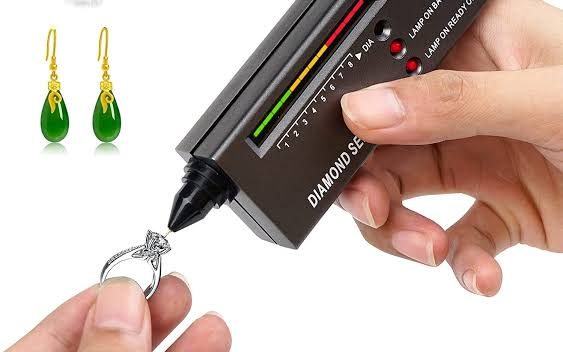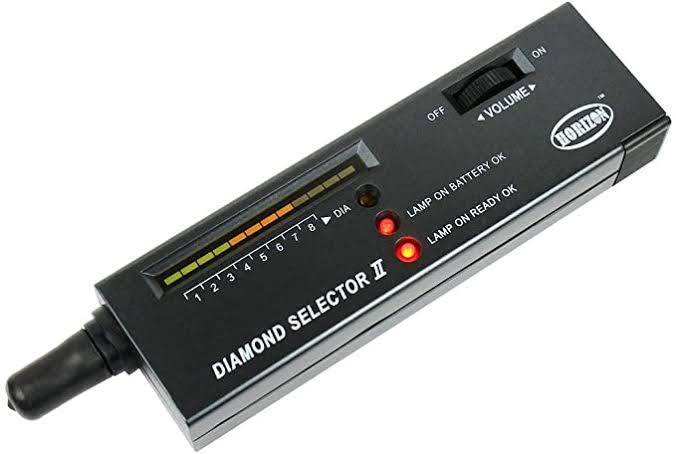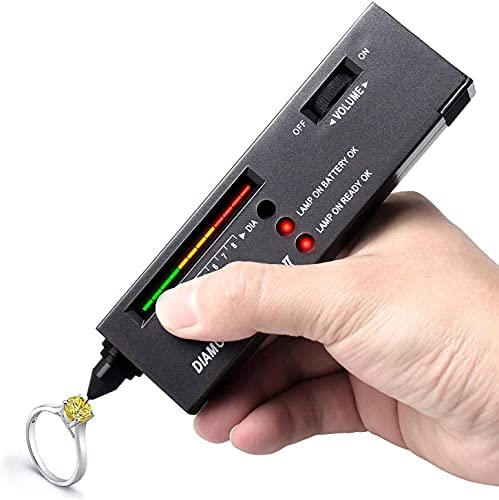The first step in learning to use the diamond selector is to find the starting number. This will only be a guide. If the light changes quickly, it means the stone is a diamond. All other gemstones conduct heat differently, so using the diamond selector will help you determine whether the stone is a diamond. In addition, different temperatures react differently to the diamond test, so stones that are in direct sunlight will react slowly and those at room temperature will react faster.
The diamond selector II is an electronic device that allows you to tell the difference between real diamonds and simulated ones. Because it uses a safe and simple method, this test can be used to identify fake stones. This tool kit is designed for both exposed and inlaid diamonds. In fact, moissanite can pass for a diamond on the diamond tester pen if it is placed correctly on the exposed side of the stone.

Have you Ever Wondered Whether your Costly Rings are Really Worth it?
The availability of greater actual and faux diamonds available in the marketplace can result in surprisingly precious or maybe nugatory portions of rings.
Fortunately, the development of generation is making matters greater handy with new diamond testers which have proved useful for genuine situations. But how do those diamond testers work, and how dependable are they? Read directly to analyze greater diamond testers.
What is a Diamond Tester?
A diamond tester is a tool used to test the authenticity of a specimen stone via means of trying out thermal or electric conductivity. If the specimen stone meets herbal diamond examined properties, it\’s going to imply or provide an audible signal. Diamond testers are the portable, way to their small frame sizes.
How can you use it?
Upon selecting a stone, you should remove the cap on the device. The cap will protect the diamond selector tip from damage. Once you have selected the stone, the tester will turn solid red or green. Place the diamond selector segment on the stone at the correct angle. While you are testing, the selector should be firmly positioned to ensure accurate readings. If the tip is not firmly placed, the device may break.
How does it Work?
A thermal conductivity tester is a common device that heats the specimen stone with a needle-like metal tip. The time it takes for heat conductivity to circulate through the rock determines if it is a natural diamond. Even better, a buzzer sound or visual reading of the tester makes the job easier.
Thermal conductivity testers rely upon the truth that gemstones, glass, or cubic zirconia behave in warmth differently. Therefore, diamond testers are constantly correct approximately their findings.
New Adjustment
New adjustments have made diamond testers extra sophisticated. The new electric gadgets which can be to be had withinside the marketplace can pick out artificial diamonds. However, their findings are primarily based totally on the identical ideas to thermal diamond testers, with electric conductivity as the principal difference.
The tester will specify the price of the warmth switch thru the stones, telling you if the gemstone is real or fake. The diamond testers may also take a look at the stone’s electric conductivity, and that they paint at the identical principle, checking out for the conductivity of energy in preference to that of warmth.
In maximum cases, the diamond testers are utilized by the jewelers to decide the authenticity of the diamond rings, mainly in case you take rings to the jewelry keep with the goal of promoting or changing it. Just to ensure that the gemstones are real, the diamond tester could be used.
Thermal Conductivity
Diamond testers, as stated above, will take correct measurements of the thermal conductivity of the diamonds/ gemstones examined to decide if the diamond is a simulated piece or a true diamond. However, the diamond tester is not able to appropriately take a look at for or pick out the artificial stone referred to as the moissanite as it stocks equal thermal conductivity as diamonds.
How Reliable are Diamond Testers?
Diamond testers are ever-correct tools. They assist in perceiving proper diamonds at a genuine moment. Unfortunately, thermal conductivity testers may be defective while moissanite is at hand. This is due to the fact that moissanite and diamond behave warmly at a comparable rate. But that shouldn’t freak you out due to the fact that electric conductivity testers are available in handy. Despite the 2 stones sharing identical thermal conductivity, moissanite and diamonds have exclusive prices for engaging in electricity. And that could be trouble solved.
Available Types Of Diamond Testers
The marketplace these days gives several sorts of diamond testers. The differing types include:
- The Conventional or Thermal Diamond tester
- Electrical conductivity diamond tester
- Diamond indenter hardness tester
- Fluorescence diamond testing
Low-Cost Diamond Tester
The Diamond Selector II is a low-cost diamond tester pen that distinguishes diamonds from other gemstones with ease. This beauty can be used on any gem with a carat weight of 0.01 carats or more. It has a basic and straightforward design that makes it simple to use for both amateurs and pros. This diamond tester pen is a perfect tool to bring along to forthcoming trade events, business meetings, and supplier visits because of its tiny and lightweight form.
Diamond Selector II Test Kit – Jewelry Gold Gem Tester Tool LED Electronic Gemstone Pen Testers with Case Professional Tools Jade Ruby Stone Devices for Jewelers Precious Metal Verifier Gems Detector
Features
- DETECTION WAY: The tester indicates genuine diamond or fake. The thermal conductivity meter is designed and manufactured according to the thermal conductivity of diamond. The fake crystal, a simulant such as cubic zirconia does not have any reaction.
- TESTER SIZE: The tool dimensions are 6.6 IN long, 1.6 IN wide, and 0.8 IN thick. The portable gadget is lightweight, matched with a practical carrying case.
- RESULT INDICATOR: There are the LED indicator and the audible signal A red light will be displayed and an audible indicator will sound if the stone is a real diamond.
- EASY TO OPERATE: Simple calibration for stones of various sizes. Easy to use even for a new beginner. It is also a great tool to have when testing your own jewelry.
- CHECKING GEM: The selector is mainly used for industrial purposes, circuit boards, and printing, industry, gardening, coin, diamond, stamp, jewelry, appraisal, education, geography, home, and office.
Quality of Diamond Tester
The diamond tester, for example, the JEM-II, is designed with a metal alert machine which is supposed to lessen a faux high-quality studying that might end result from the tester touching the metal, even supposing the stone isn\’t always a diamond or a few different forms of the gemstone. The tester is calibrated for ease of use and correct readings with the metered volume, which fits stones of various sizes. It additionally has the capability to discover stones that can be as small as 0.2ct. You’d need to join the tester to an AC adapter to be used indoors, however, the tester doesn’t include the AC adapter this is needed. You may be satisfied to recognize that given the small length of the tester, you could deliver it in your pocket.
Testing Gemstones Using the Diamond Tester
- You have to usually easily the tester and the probe very well earlier than you operate them.
- When geared up to apply the tester, get rid of its protecting cap lightly from the probe tip.
- Next, keep the diamond tester together along with your proper hand’s index finger so you contact its electricity-undertaking panel on the pinnacle of the diamond tester.
- You’d need to press down the probe’s tip on the proper perspective at the stone. Just ensure now no longer press the tester at the stone at much less than ninety degrees.
- Also, don’t follow an excessive amount of pressure due to the fact it is able to bend or ruin the probe.
- Once you’re geared up to test, keep checking out probe settings with the left hand.
- If you\’re checking out for the free stones, you have to location them withinside the checking out base – you could use one hand to steady the base
What Time does it Take?
Warming up this inexpensive diamond testing pen takes less than 10 seconds. All that’s left to do now is place the probe on the gem you want to test. After that, your diamond tester will tell you whether or not you’re dealing with a diamond. This diamond tester pen’s backlit LED indicator lights make it simple to view test results at any time of day. Between tests, there is just a 2-second recuperation period. This means you’ll be able to check numerous stones at once in a short amount of time. You’ll be treated to highly accurate test results at any time thanks to its high-quality thermos probe. If you’re looking for something specific,
Setting Sensitivity
However, this machine can make mistakes and it isn’t perfect. While the diamond selector can tell the difference between a real diamond and a fake one, it cannot differentiate between a diamond and moissanite. Diamonds and moissanite conduct electricity and heat differently. Therefore, the diamond selector must be used with caution. You should also pay attention to the setting sensitivity and the speed at which the segment lights will flash to determine whether the stone is real or not.
Conclusion
Before using the diamond selector, you should know how to read the tester. To use it, you must make sure that your hands are moist. This is because the device cannot detect the diamond if they’re dry or have been covered in vaseline. Make sure that you use your left hand when you hold the device. The diamond selector has several settings that can help you determine the size of the stone. Once you’ve set the size, the device will display the number of the stone.
The tester should be held in the right hand with the index finger of the left hand touching the electricity-conducting panel at the top of the device. While holding the diamond tester, you should hold the stone to be tested by its setting. Make sure to guide the probe tip to the center of a facet on the stone. Be sure not to use too much force as this may break the probe tip or bend it.









